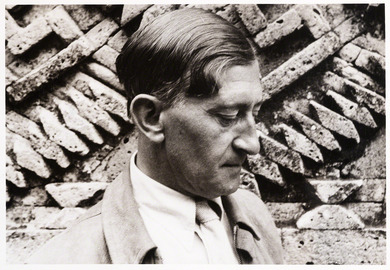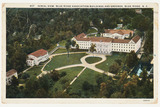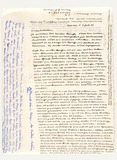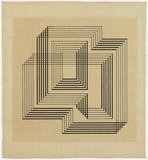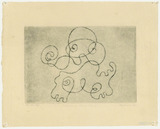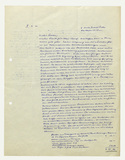Josef Albers
Es ist der Tätigkeit Albers zu verdanken, dass der von ihm in Weimar und Dessau ausgearbeitete Vorkurs, den er zusammen mit seinen Schülern im Black Mountain College weiterentwickelte, zur Grundlage der künstlerischen Ausbildung in den USA wurde.
[It is thanks to Albers that the preliminary course originated by him in Weimar and Dessau, and which he developed together with his students at Black Mountain College, became the basis of artistic education in the United States. (ed. trans.)]
Jessica Boissel, Josef Albers and Wassily Kandinsky, 1998
| Born | on 19 March 1888 in Bottrop, Germany |
|---|---|
| Died | on 25 March 1976 in New Haven, United States |
| Exile | United States of America |
| Remigration | Federal Republic of Germany |
| Profession | Painter, Graphic designer |
Josef and Anni Albers lost their jobs when the Bauhaus was closed in the summer of 1933. Alarmed by the anti-Semitism, the couple never hesitated in following the call to the United States.
Josef Albers studied from 1920 at the Bauhaus in Weimar, where he specialised in glass work. Walter Gropius entrusted different courses to him in 1923. When the Bauhaus moved to Dessau in 1925, Albers was appointed Meister and married the Bauhaus student Anneliese Fleischmann, whose family was of Jewish extraction.
In 1927 Philip C. Johnson, curator of the Department of Architecture and Industrial Design at the Museum of Modern Art in New York, visited the Bauhaus in Dessau together with the Museum Director Alfred H. Barr. Impressed by the Bauhaus preliminary course, Johnson recommended Josef Albers to the Black Mountain College which had been newly opened in 1933, and where Albers was eventually appointed. He and his wife turned their back on Germany on 17 November 1933 by boarding the SS Europa Germany; they reached New York on 24 November. Four days later Josef and Anni Albers arrived at Black Mountain College. Albers was appointed professor of fine arts at the experimental school and initially taught material studies and drawing, followed later by introduction to colour theory.
In 1949, after serving for a year as the school's principal, he left Black Mountain College and moved to New York. From 1950, Josef Albers found a new home in New Haven where he took up the post of Head of the Department of Design at Yale University School of Art.
Selected works:
Pergola (Glass picture, 1929)
Runde (Woodcut, 1933)
Violinschlüssel Go (Gouache, 1932/35)
Durchdringung (A) (Painting, 1938)
Hommage to the Square (Painting, 1951)
Structural Constellation F-32 (Formica engraving on wooden board, 1954)
Further reading:
Schell, Maximilian: Anni und Josef Albers. Eine Retrospektive. München 1989.
Bernstein, Sheri: Josef Albers am Black Mountain Collage, 1933-45. In: Exil. Flucht und Emigration europäischer Künstler 1933-1945. Stephanie Barron (Hg.). München: Prestel 1997, 254-261.

